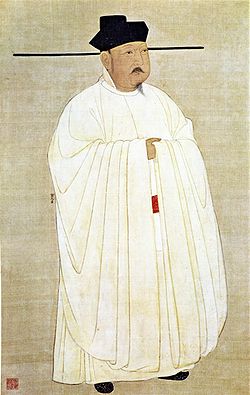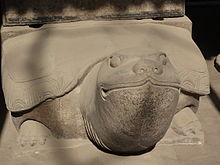- Emperor Taizong of Song
-
Emperor Taizong of Song 
Emperor of the Northern Song Dynasty Reign 15 November 976 – 8 May 997 (20 years, 174 days) Predecessor Emperor Taizu Successor Emperor Zhenzong Spouse Empress Yin 淑德皇后
Empress Fu 懿德皇后
Empress Li 明德皇后
Empress Li 元德皇后[1]
Consort Sun, concubine
Consort Zang, concubine
Consort Fang, concubine
Consort Zhu, concubine
Consort Gao, concubine
Consort Shao, concubine
Consort Li, concubine
Consort Wu, concubineIssue Zhao Yuanzuo, Prince Xian of Hangong
Zhao Yuanxi, Crown Prince Zhaocheng
Zhao Heng, Emperor Zhenzong
Zhao Yuanfen, Prince Gongjing of Shang
Zhao Yuanjie, Prince Zhaowen of Hui
Zhao Yuanwo, Prince Gongyi of Zhen
Zhao Yuandai, Prince Chugong of Hui
Zhao Yuanyan, Prince Gongsu of Zhou
Zhao Yuanyi, Prince of Chong
Princess Teng
Princess Xu
Princess Bin
Princess Yang
Princess Ju
Princess Wei
Princess QiaoFull name Family name: Zhào (趙) Posthumous name Short: Never used short
Full: Emperor Zhiren Yingdao Shengong
Shengde Wenwu Ruilie Daming Guangxiao
至仁應道神功聖德文武睿烈大明廣孝皇帝[2]Temple name Taizong (太宗) House House of Zhao Father Zhao Hongyin 趙弘殷 Mother Lady Du 杜氏 Born 20 November 939 Died 8 May 997 Emperor Taizong (November 20, 939 – May 8, 997), born Zhao Kuangyi, was the second emperor of the Song Dynasty of China from 976 to 997. He was the younger brother of Emperor Taizu. His temple name Taizong means "Grand Ancestor".
Contents
Overview
Emperor Taizong was remembered as a hardworking and diligent emperor. His most notable achievement was the reunification of China through the conquest of Northern Han. He personally led the campaign against Northern Han in 979 and ordered the flooding of enemy cities by releasing the Fen River. The Northern Han ruler Liu Jiyuan (劉繼元) was forced to surrender.
He paid great attention to the welfare of his people and made his empire more prosperous. He adopted the policies previously enacted by Emperor Shizong of Later Zhou, which include increasing agricultural production, broadening the imperial examination system, compiling encyclopedias, expanding the civil service and further limiting the power of Jiedushis.
Campaigns against the Liao Empire
First campaign
Having conquered Northern Han in 979, Emperor Taizong took advantage of the momentum and launched another military campaign against the Liao Dynasty. In May 979, Taizong embarked on his campaign from Taiyuan and took the Zhuo and Yi prefectures easily. He besieged Yanjing (present-day Beijing) after the success. However, the siege failed when the Liao defending general Yelü Xuegu defended the fortress firmly.
Concurrently, Liao reinforcements led by Yelü Xiuge arrived from the Gaoliang River region, west of Yanjing. Taizong ordered his army to attack the reinforcements. Initially, he received reports that the Liao army was suffering heavy casualties. He ordered a full assault on the Liao army as he thought that the whole battle was under his control. Just then, Yelü Xiuge and Yelü Xiezhen's armies attacked from two sides. Yelü Xiuge concentrated on attacking Taizong's main camp. Taizong was shocked and evacuated from the battlefield. During the evacuation, the Song army was divided and obliterated by the Liao cavalry.
Amidst the onslaught, Taizong fled towards Yi Prefecture and arrived there safely with his generals protecting him. He sustained an injury from an arrow and was unable to ride on his horse and had to travel by carriage back to Ding Prefecture. Taizong ordered a retreat after that. The Song army was without a commander as Taizong was separated from his troops. The troops suggested that Emperor Taizu's eldest son Zhao Dezhao (Emperor Taizong's nephew) be the new emperor. Taizong's suspicions were raised when he heard that and eventually he ordered Zhao Dezhao to commit suicide.
The Battle of Gaoliang River was significant as it was one of the major contributing factors to the Song Dynasty's decision to adopt a defensive stance. The early Song army suffered its first major defeat in battle. Meanwhile, Taizong was also troubled by the possibility that Zhao Dezhao would launch a coup. After the battle, Taizong personally inspected and focused more on the development and strengthening of his military forces. He ignored his subjects' advice and regarded state affairs as of lower importance. He also limited the power and control that the imperial family and military officers had over the army.
Second campaign
After the death of Emperor Jingzong of Liao in 982, the 12-year-old Emperor Shengzong of Liao ascended to the throne of the Liao Dynasty. As Emperor Shenzong was too young to rule the kingdom, the Empress Dowager Xiao became the regent. Emperor Taizong decided to launch the second campaign against Liao in 986, following the advice of his subjects.
Emperor Taizong remained in Kaifeng and directed the war there without personally entering the battlefield. He split the army into three sections - East, Central and West. The East Army was led by Cao Bin, the Central Army by Tian Zhongjin and the West Army by Pan Mei and Yang Ye. All the three armies would attack Yanjing from three sides and capture it. The campaign was termed as the Yongxi Northern Campaign as it took place in the third year of the Yongxi reign of Emperor Taizong.
The three armies scored some victories initially but they became more divided later as they acted individually without co-operation. Cao Bin took the risk by attacking without the support of the other two armies. He succeeded in taking Zhuo Prefecture but the lack of food supplies forced him to retreat. As there was miscommunication between the three armies, the East Army attacked Zhuo again. However, this time, Empress Dowager Xiao and Yelü Xiuge each led an army to support Zhuo. The East Army was inflicted with a crushing defeat and almost completely destroyed.
Emperor Taizong was aware that the failure of the East Army would affect the entire campaign and he ordered a retreat. He ordered the East Army to return, the Central Army to guard Ding Prefecture and the West Army to guard four prefectures near the border. Following the defeat of the East Army, the Liao army led by Yelü Xiezhen attacked them as they retreated. The West Army led by Pan Mei met Yelü Xiezhen's army at Dai Prefecture and faced another defeat at the hands of the Liao army. The two commanders of the West Army started to argue about retreating. Yang Ye proposed that they should retreat since the East and Central Armies had already lost the advantage following their defeats. However, the other generals on Pan Mei's side began to doubt Yang's loyalty to Song as Yang Ye used to serve Northern Han. Yang Ye led an army to face the Liao troops but they were trapped and Yang committed suicide eventually. Pan Mei was supposed to arrive with reinforcements to support Yang but he failed to do so.
Emperor Taizong ordered another retreat following the Song armies' defeats by Liao's Yelü Xiuge and Yelü Xiezhen. The failure of the second campaign was attributed to the miscommunication between the three armies and their failures to operate together. Besides, Emperor Taizong had also restricted the decisions of his generals as he had arbitrarily planned the whole campaign on Liao and his generals had to adhere to his orders strictly. These failures led to internal rebellions which were crushed swiftly.
In 988, the Liao armies led by Empress Dowager Xiao attacked the Song border again. Emperor Taizong did not order a counter-attack and merely instructed the troops to defend firmly.
Later reign after 988
Emperor Taizong felt that he could not surpass his brother (Emperor Taizu) in terms of military conquests and achievements and decided to focus more on developing his dynasty internally and establish his legacy. He implemented a series of economic and literary reforms which were better than his brother's. He also initiated many construction projects and inducted new systems absent in Emperor Taizu's reign.
Emperor Taizong died in 997 after reigning for 21 years at the age of 57. He was succeeded by his third son, who became Emperor Zhenzong of Song.
Personal information
Monument in memory of renovating the Temple of Confucius in Qufu. Year 8 of the Taipingxingguo era (AD 983) (top of the stele) Monument in memory of renovating the Temple of Confucius in Qufu. Year 8 of the Taipingxingguo era (AD 983) (tortoise pedestal)
Monument in memory of renovating the Temple of Confucius in Qufu. Year 8 of the Taipingxingguo era (AD 983) (tortoise pedestal)
- Father
- Zhao Hongyin, posthumously honored as Emperor Xuanzu
- Mother
- Lady Du, Zhao Hongyin's wife, daughter of Grand Perceptor Du Shuang and Lady Fan, posthumously honored as Empress Dowager Zhaoxian
- Wife
- Empress Yin, daughter of Yin Tingxun (尹廷勛), Provincial Governor of Chuzhou; posthumously honored as Empress Shude (淑德皇后)
- Empress Fu (941 - 975), sixth daughter of Fu Yanqing, Prince of Wei; posthumously honored as Empress Yide (懿德皇后)
- Empress Li (960 - 15 March 1004), daughter of Li Chuyun (李處耘); formally Empress Mingde (明德皇后)
- Empress Li (943 - 977), daughter of Li Ying (李英); mother of Princes Yuanzuo and Heng and Princess Teng; posthumously honored as Empress Yuande (元德皇后)
- Concubine
- Consort Sun
- Consort Zang
- Consort Fang
- Consort Zhu
- Consort Gao
- Consort Shao
- Consort Li
- Consort Wu
- Sons
- Zhao Yuanzuo 趙元佐 (965 - 1027), Prince Xian of Hangong
- Zhao Yuanxi 趙元僖 (966 - November 992), Crown Prince Zhaocheng
- Zhao Heng 趙恆 (23 December 968 - 23 March 1022), Emperor Zhenzong
- Zhao Yuanfen 趙元份 (969 - 1005), Prince Gongjing of Shang
- Zhao Yuanjie 趙元傑, Prince Zhaowen of Hui
- Zhao Yuanwo 趙元偓, Prince Gongyi of Zhen
- Zhao Yuandai 趙元侢, Prince Chugong of Hui
- Zhao Yuanyan 趙元儼, Prince Gongsu of Zhou
- Zhao Yuanyi 趙元億, Prince of Chong
- Daughters
- Princess Teng (滕國公主), died young
- Princess Xu (徐國大長公主), married Left General Wu Yuanyi (左衛將軍吳元扆)
- Princess Bin (邠國大長公主)
- Princess Yang (揚國大長公主), married Left General Chai Zongqing (左衛將軍柴宗慶)
- Princess Ju (雍國大長公主), married Right General Wang Yiyong (右衛將軍王貽永)
- Princess Wei (衛國大長公主)
- Princess Qiao (荊國大長公主), married Li Zunxu (李遵勗)
Ancestry
Ancestors of Emperor Taizong of Song 16. Zhao Tiao 8. Zhao Ting 17. Lady Cui 4. Zhao Jing 9. Lady Sang 2. Zhao Hongyin 5. Lady Liu 1. Zhao Kuangyin, Emperor Taizong of Song 6. Grand Perceptor Du Shuang 3. Lady Du 7. Lady Fan See also
- List of Song Emperors
- Architecture of the Song Dynasty
- Culture of the Song Dynasty
- Economy of the Song Dynasty
- History of the Song Dynasty
- Society of the Song Dynasty
- Technology of the Song Dynasty
Notes and references
Emperor Taizong of SongHouse of Zhao (960–1279)Born: 939 Died: 997Regnal titles Preceded by
The Taizu EmperorEmperor of the Song Dynasty
976–997Succeeded by
The Zhenzong EmperorEmperor of China
976–997List of emperors of the Song Dynasty Northern Song
Taizu 太祖 · Taizong 太宗 · Zhenzong 真宗 · Renzong 仁宗 · Yingzong 英宗 · Shenzong 神宗 · Zhezong 哲宗 · Huizong 徽宗 · Qinzong 欽宗 ·Southern Song
Gaozong 高宗 · Xiaozong 孝宗 · Guangzong 光宗 · Ningzong 寧宗 · Lizong 理宗 · Duzong 度宗 · Gongzong 恭宗 · Duanzong 端宗 · Emperor Bing 帝昺Categories:- 939 births
- 997 deaths
- Song Dynasty emperors
- 10th-century Chinese monarchs
- 10th-century rulers in Asia
- Father
Wikimedia Foundation. 2010.


